Outforia Quicktake: Key Takeaways
- There are more than 260 different types of monkeys in the world, living primarily in Africa, Asia, South America, Central America, and parts of Mexico. They can adapt to a variety of environments, including forests, cities, mountains, and deserts.
- Monkeys are usually quite sociable and live in groups called troops, which can vary from a small family group to a collection of many hundreds of individuals. They communicate using sounds, facial expressions, and pheromones.
- Monkeys’ diets vary greatly depending on the species, including fruit, nuts, seeds, tree sap and gum, or leaves. Some species are more omnivorous and eat insects, eggs, and even small animals, whereas others, like geladas, only eat grass.
- Approximately half of all monkey species are listed as at least threatened, due to habitat loss, human conflict, hunting, or trapping for the international pet trade. However, many more are species of least concern.
- While monkeys and apes may look similar, they are different animals. Apes generally have larger bodies, larger brains, and no tail. Meanwhile, monkeys usually have smaller bodies, long and thin arms, and a tail. Both apes and monkeys belong to the order Primates, but are classified under different superfamilies.

Monkeys are our closest relatives in the animal kingdom. But how much do you actually know about these remarkable creatures?
Whether you’re a certified primatologist or you’re simply keen to learn more about our primate cousins, we have the information you seek right here.
In this article, we’ll introduce you to the 25 most amazing types of monkeys in the world. From intelligent chimpanzees to beautifully colosred mandrills, we have photos and fun facts about all the world’s most spectacular primate species.
As an added bonus, we’ve also included some information on how monkeys are classified as well as some insight into the wonderful world of primates. That way, you can brush up on your monkey knowledge for the next time you see these fantastic mammals on your travels.

Share this Image On Your Site
<a href="https://outforia.com/types-of-monkeys/"><img style="width:100%;" src="https://outforia.com/wp-content/uploads/2021/04/Types-of-Monkey-Infographics.jpg"></a><br>Monkey Infographic by <a href="https://outforia.com">Outforia</a>The 25 Most Extraordinary Types of Monkeys
There are more than 260 different types of monkeys in the world today, so we couldn’t possibly list them all here. However, we’ve compiled this list of the 25 most astounding types of monkeys so you can learn more about these amazing primates.
1. Golden Snub-Nosed Monkey (Rhinopithecus roxellana)


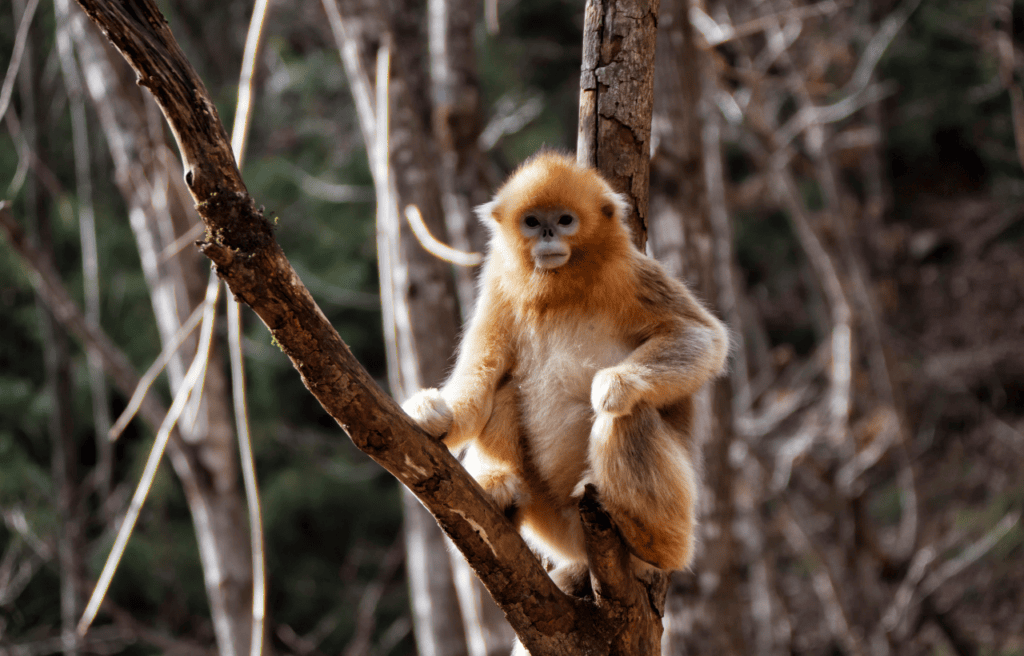
One of the most visually striking types of monkeys, the golden snub-nosed monkey, also known as the Sichuan snub-nosed monkey, is a highly sociable type of Old World monkey that lives in a small, fragmented area of the Tibetan Plateau in China.
These beautiful primates have long, golden orange fur coats and bright blue faces. Due to the extreme habitats that they call home, scientists believe that they’ve evolved to have flattened snub boats to protect them against frostbite.
In fact, it’s believed that the golden snub-nosed monkey is the most cold-tolerant of all non-human primate species.
While these monkeys do live in forested terrain, the frigid winter temperatures of the Tibetan Plateau can easily drop well below freezing. When this happens, the golden snub-nosed monkey is known to huddle with its young and other members of its social group to stay warm.
Unfortunately, these monkeys are considered to be one of the most endangered primates in the world. It’s believed that deforestation is one of the main causes of the species’ decline, though poaching for fur, meat, and the traditional medicine trade is also a concern.
2. Mandrill (Mandrillus sphinx)



Arguably one of the most recognizable of the Old World monkeys, mandrills are large primates native to western and central Africa. They visually resemble baboons, though recent genetic studies suggest that they are less closely related than we originally thought.
Mandrills are best known for their extreme sexual dimorphism, which means that the males and females vary greatly in terms of visual presentation. For example, the male mandril will usually be three times larger than the female. It will also have a brightly colored face and a distinctive blue backside.
These monkeys like to live in densely forested areas where they try to avoid human contact. Most mandrills prefer to stay on the ground, though they are also adept climbers.
Mandrills are currently listed as vulnerable by the IUCN. The main reason for its vulnerable status is the widespread deforestation that takes place in its range. However, it is also regularly hunted for bushmeat, which is believed to be the species’ chief concern.
3. Proboscis Monkey (Nasalis larvatus)



Featuring a truly distinctive face, the proboscis monkey, or long-nosed monkey, is a stunning primate that lives in mangrove forest areas in Indonesia, Malaysia, and Brunei. The proboscis monkey is best known for its spectacularly large nose, which is much more evident in males than in females.
Proboscis monkeys’ large nose is believed to be an echo chamber. In fact, scientists believe that this echo chamber helps to amplify the male proboscis monkey’s call to females in order to help them attract a mate.
These monkeys prefer to live in wetlands, coastal areas, swamps, and other low-lying regions where they can find their preferred food: leaves. Interestingly, proboscis monkeys have a unique multi-chambered stomach that’s specifically designed to help them digest leaves.
Nevertheless, like most types of monkeys, proboscis monkeys are listed as endangered due to widespread habitat loss. They are also hunted both for food and for various body parts that are used in traditional medicines.
4. Snow Monkey (Macaca fuscata)
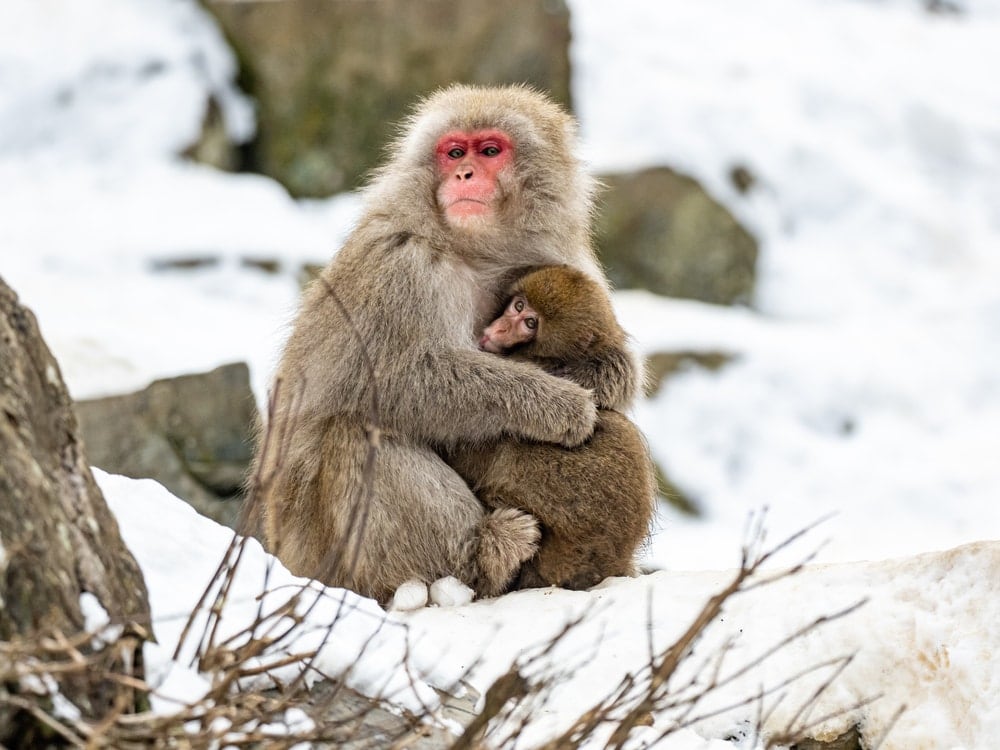


Another highly recognizable type of monkey, snow monkeys (a.k.a. Japanese macaques) are found throughout the islands of Kyushu, Shikoku, and Honshu in Japan. These furry monkeys have a thick coat of tan-colored fur and pink faces with strikingly human-esque characteristics.
They prefer to live in some of the coldest regions of Japan where they seek out thermal springs for warmth. Indeed, they’ll often be found gathering in groups in thermal baths that are heated by Japan’s geothermal activity.
Furthermore, snow monkeys are known for being highly sociable. They live in social groups where they pass along certain behaviors, like making snowballs just for fun, from generation to generation.
Thankfully, snow monkeys are one of the least threatened primate species. They are currently listed as a species of least concern and their population seems to be increasing.
5. Black Snub-Nosed Monkey (Rhinopithecus bieti)



A close cousin of the golden snub-nosed monkey, the black snub-nosed monkey is a medium-sized monkey that lives in the mountainous regions of southwestern China.
Also called the Yunnan snub-nosed monkey, this primate features a characteristic snub-nose and a beautiful black fur coat to help it stay warm in its mountainous habitat.
These monkeys love to feed on lichens, which make up about two-thirds of its diet. This is actually quite rare among primates, but the black snub-nosed monkey has a multi-chamber-type stomach that helps it digest its food.
It’s believed that the black snub-nosed monkey lives at a higher elevation than any other primate species besides humans. They are often found up to 15,000 feet (4,700 m) above sea level and they will travel to higher elevations in the winter in search of food.
These days, the black snub-nosed monkey is considered to be endangered as there are believed to be fewer than 2,000 individuals in the wild. The main concern for this species is poaching and habitat loss.
6. Barbary Macaque (Macaca sylvanus)



Europe’s only primary species, the Barbary macaque is found throughout northern Africa and in a small, isolated part of Gibraltar on the European mainland. They are medium-sized primates with thick fur and pink faces that are known to get very habituated to humans, particularly in Gibraltar.
The Barbary macaque is believed to have been introduced to Gibraltar between the years 700 and 1500 as they were kept as pets by the Moors. However, the population of the macaque in Gibraltar was completely wiped out by disease in the 1900s, so officials reintroduced them to the region from North Africa.
Interestingly, the Barbary macaque is one of the few Old World monkey species that does not have a tail. Furthermore, they are highly social monkeys that like to live in troops of up to about 60 individuals.
Due to the small, fragmented nature of the Barbary macaque population, it is considered to be endangered. But, the monkeys are easy enough to spot in Gibraltar, where they like to hang out by the visitor center on the Rock of Gibraltar.
7. Crab-Eating Macaque (Macaca fascicularis)



Contrary to their name, crab-eating macaques don’t actually eat crabs. Rather they live in parts of southeastern Asia, particularly around Indonesia and the Philippines, where they prefer to eat fruit.
They have an excitable personality and a highly social disposition, though they have sometimes become pests in densely-populated human environments. However, fighting within the monkey’s social groups is common, though the crab-eating macaque has also been seen reconciling with others after a fight.
The species is listed as vulnerable even though it has one of the largest ranges of any primate species. This is mostly because of habitat loss and fragmentation. Furthermore, the species has long been used in scientific research, so demand for the monkey for human purposes is quite high.
8. Common Marmoset (Callithrix jacchus)



Sometimes called the white-tufted-ear marmosets, the common marmoset is a small primate found mostly in Brazil. They can live in a wide range of different habitats, including in rainforests and urban locales.
These monkeys prefer to eat insects, though they will also snack on tree sap, gum, resins, and the like. For the most part, common marmosets like to live in groups of around nine individuals. Their social groups can contain up to three generations of a single family, which is rare in the monkey world.
Common marmosets have adorable white-tufted ears, which has made them popular as pets. However, they don’t thrive in captivity and the illegal trade of common marmosets has caused their population numbers to twindle in recent years.
9. Panamanian White-Faced Capuchin (Cebus imitator)



One of the most adorable capuchin species, the Panamanian white-faced capuchin is traditionally found throughout Ecuador, Colombia, and Panama. It is often regarded as one of the most resourceful of the New World monkeys because it will often create tools and weapons for hunting and self-protection.
Panamanian white-faced capuchins like to live in forested habitats, particularly wherever there are old-growth trees. They also have a prehensile tail, which helps them hang from branches and perform certain tasks.
Like many other primates in their region, the Panamanian white-faced capuchin is considered to be vulnerable. Its main threats are habitat degradation and hunting, though it is often illegally trapped and sold as a pet.
10. Central American Spider Monkey (Ateles Geoffroyi)



Sometimes called the Geoffroy’s spider monkey or the black-handed spider monkey, the Central American spider monkey is a small, mostly black-colored primate that lives throughout Central America.
It prefers to live in forested locales, particularly in the rainforest where it can swing from tree to tree. They like to eat fruit, though you can sometimes find them eating leaves, nuts, seeds, and even eggs.
In the wild, Central American spider monkeys are listed as endangered. While they are somewhat tolerant of logging and habitat fragmentation, the widespread habitat loss in their range has caused a decline in the population.
However, the main reason behind the species’ endangered status is the fact that it’s very popular in the pet trade. These monkeys have also been known to spread diseases to humans, so most experts strongly advise against keeping them as pets.
11. Pygmy Marmoset (Callithrix pygmaea)



The world’s smallest monkey, the pygmy marmoset is an adorable primate that lives throughout the rainforests of South America. Its small stature and brownish fur coat make it look a lot like a type of squirrel, but the pygmy marmoset is, indeed, a monkey!
Pygmy marmosets are closely related to tamarins, which are also quite small. However, they are identified by their massive tail, which is usually longer than their bodies. While the pygmy marmoset’s tail isn’t prehensile, it does help the monkey keep its balance as it travels through the trees.
For the most part, pygmy marmosets like to eat tree sap, which they collect by creating tiny holes in the trees in their native habitat. That being said, the very small size of pygmy marmosets means that they are often preyed upon by cats, like jaguars, that also roam the rainforest.
The pygmy marmoset is currently listed as a species of least concern by the IUCN, so it is one of the relatively few primates that is not endangered.
12. Northern Plains Gray Langur (Semnopithecus entellus)



One of the eight species of gray langurs, the northern plains gray langur is a large primate that’s found throughout the forests of India. These monkeys are considered to be sacred in many local cultures, though they are currently decreasing in population due to habitat loss and fragmentation.
Northern plains gray langurs prefer to live in dry and deciduous forests, but you can also find them in regions with human-dominated landscapes, like cities.
Perhaps the most unique aspect of the northern plains gray langur is its large tail. These monkeys have tails that are more than one and a half times the length of their bodies, which helps them with balance when swinging through the trees.
Interestingly, these monkeys are very vocal. They are known to make more than 20 different vocalizations to communicate with the rest of their troop. These monkeys will also use facial expressions to communicate, just like us humans.
13. Gee’s Golden Langur (Trachypithecus geei)



Featuring a handsome golden coat, the Gee’s golden langur is a beautiful monkey that lives in India and Bhutan. The Gee’s golden langur is actually one of the more recently identified species of monkey, so it’s not well studied.
These monkeys tend to live in a range of habitats, including in highly forested terrain. Nevertheless, its habitat is highly fragmented, which is one of the reasons why it is listed as endangered.
The Gee’s golden langur has a slim body, long limbs, and a gorgeous golden color that contrasts beautifully with its black face. Despite their distinct coloration, these monkeys are quite shy, so consider yourself lucky if you see one in the wild.
14. Bald Uakari (Cacajao calvus)



An unmistakable species, the bald uakari is a large primate found in the western part of the Amazon.
The bald uakari has a very long, shaggy brown coat and a prominent, bright-pink head that you can’t miss. Their forehead is large and bumpy, too, so it’s next to impossible to misidentify them.
Most at home in rainforests, the bald uakari prefers to live in highly fertile regions that experience seasonal floods. As a result, they have a diet that varies seasonally. They will eat anything from fruits and leaves to roots, insects, and nuts depending on the season.
Habitat loss and hunting are the main concerns for the bald uakari, which is a vulnerable species. In fact, it is likely already extinct in Colombia, which was once an important part of its range.
15. De Brazza’s Monkey (Cercopithecus neglectus)



Most at home along rivers in central Africa, the small and adorable De Brazza’s monkey is an Old World monkey that’s known for its unique coloration.
The De Brazza’s monkey got its name from Pietro Savorgnan di Brazza, who was one of the original colonizers of the land that is now Brazzaville in the Republic of the Congo. It has a greyish-black coat with a red tuft on its forehead and a white beard-like patterning that makes it easy to identify.
These monkeys are highly territorial and they can sometimes form family groups that stay together throughout their lives.
Although they are currently listed as a species of least concern, their population numbers are dropping due to hunting and habitat destruction. However, they are legally protected in Ethiopia.
16. Colombian Red Howler (Alouatta seniculus)
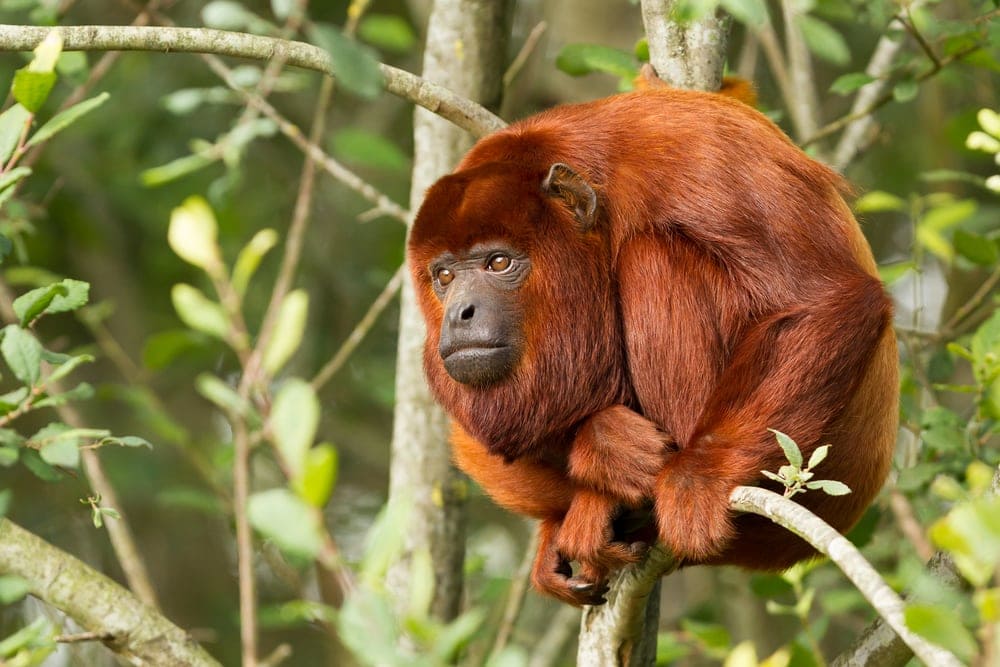


Distributed widely throughout the rainforests of South America, the Colombian red howler is one of the largest of the New World monkey species.
As their name suggests, Colombian red howlers have bright red colorations, which make them relatively easy to identify in their home range. They prefer to spend most of their time in the canopy, where their prehensile tail helps them grasp branches and other objects.
If it had its way, the Colombian red howler would eat only leaves. But, it will also eat fruits, flowers, nuts, and even other small animals to supplement its diet.
Furthermore, despite habitat loss, the Colombian red howler is listed as a species of least concern, which bodes well for its future population growth.
17. Gelada (Theropithecus gelada)
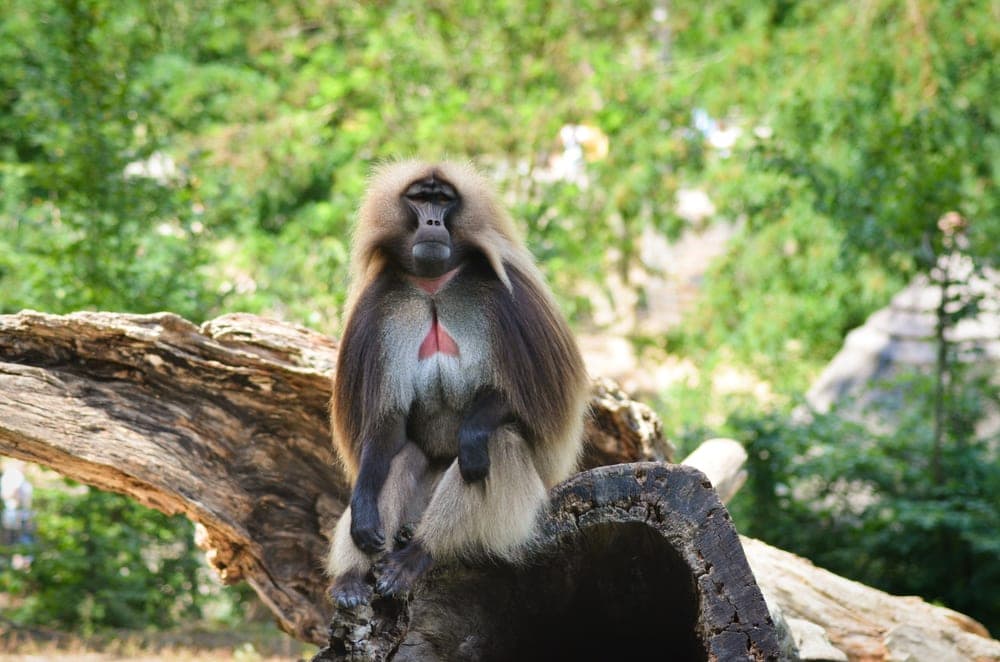


One of the few non-human primates that prefers to spend its time with both feet planted firmly on the ground, the gelada is a large, Old World monkey that lives in the grasslands of the Ethiopian Highlands.
As the only non-human primate to feed on grass, geladas can live in groups of up to 350 individuals that roam through the highlands. They have a distinctive brownish coloring with a large, pink, hourglass-shaped red area located firmly in the middle of their chests.
Geladas are listed as a species of least concern, though they are preyed upon by hyenas, leopards, jackals, servals, and wild dogs. Furthermore, the IUCN notes that their population is decreasing due to habitat loss.
18. Emperor Tamarin (Saguinus imperator)
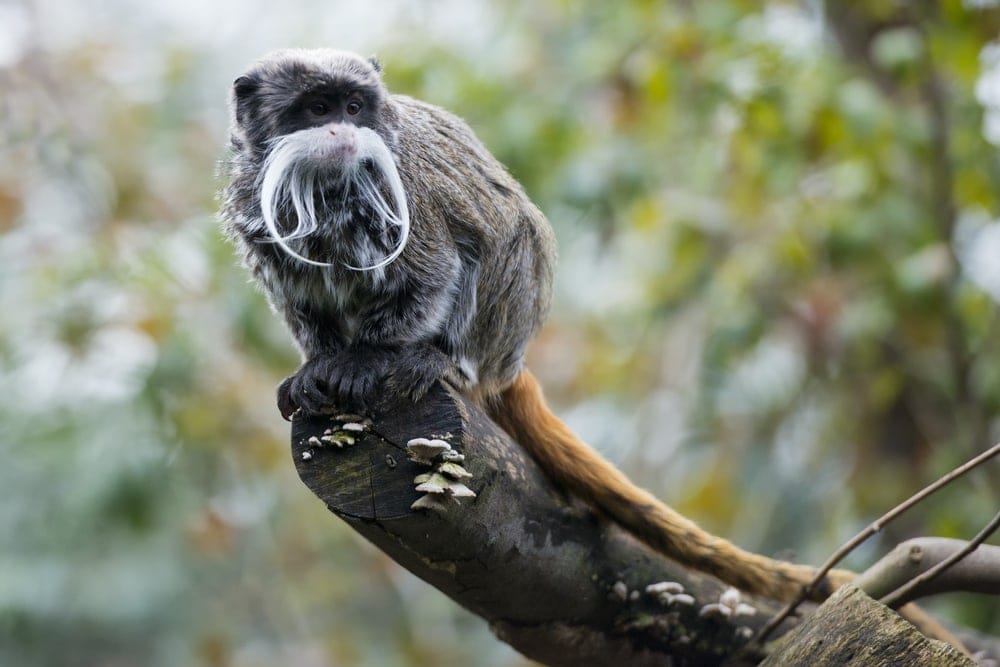


Some of the smallest monkeys in the world, the emperor tamarin is objectively cute (in our opinion, at least!).
These adorable primates have a black coat with a large, white, mustache-like tuft of fur extending from each side of their face. When combined with their small size, extra-long tail, and big brown eyes, there’s a lot to love about this cuddly-looking monkey.
Emperor tamarins are found in the Amazon River Basin where they are considered to be a species of least concern. They live in the rainforest where they feed mostly on fruit, insects, tree gum, and leaves.
Most emperor tamarins will live in large family groups, some of which can have up to 15 individuals. They can also live to be about 20 years old, which is impressive for such a small primate.
19. François’ Langur (Trachypithecus francoisi)



Sometimes called the Tonkin leaf monkey, the François langur is a rare species of langur found only in southwestern China and Vietnam. These monkeys feature a medium size and jet-black, silky fir. Their most distinctive feature, though, is their white sideburns which make them easy to identify.
Interestingly, the François langur has a unique digestive system with four separate stomach chambers. This allows them to survive off of a diet that’s almost exclusively made up of leaves.
Nevertheless, the François langur is listed as endangered. It lives almost exclusively in habitats within karst topographical landscapes, which boast limestone cliffs that the monkeys like to call home. But, habitat loss is rampant in their range, which has caused the population to dwindle to about 2,000 individuals.
20. Roloway Monkey (Cercopithecus roloway)



Boasting a striking black and white coloration, the Roloway monkey is a large primate found in Côte d’Ivoire and Ghana.
The Roloway monkey lives mostly in dense forests where it feeds off of various fruits, insects, seeds, and leaves. They tend to live in large troops that travel as a group through their native habitat.
Unfortunately, the Roloway monkey is one of the world’s most endangered primates. It is listed as critically endangered by the IUCN and its population continues to decrease. The species is already extinct in much of its range as it is not resilient in the face of widespread habitat loss.
21. East Javan Langur (Trachypithecus auratus)



Relatively small monkeys with a funky coloration, the east Javan langur is a relatively rare primate found only on the island of Javan and its minor outlying islands.
The east Javan langur has a very long tail, like other langurs. In fact, its tail is often more than twice its body length.
However, the most distinctive aspect of the east Javan langur is its unique coloration. In adulthood, the monkey has a bright orange-colored coat. But, when young, the east Javan langur is almost completely black in color. Interestingly, some east Javan langurs never lose their juvenile coloration, so you can find both black and orange langurs in the wild.
22. Red-Shanked Douc (Pygathrix nemaeus)



Among the most endangered primates in the world, the stunning red-shanked douc is found only in parts of Cambodia, Vietnam, and Laos. These monkeys have fantastically beautiful black and grey fur coats with reddish face colorations, red legs, and white, wispy fur tufts around their heads.
Red-shanked docs prefer to live in tropical and subtropical forests where they can feed on leaves, fruits, bark, and flowers. Most of them will live in family groups of less than 10 individuals.
Unfortunately, red-shanked doucs are listed as critically endangered. They are hunted both for bushmeat and for traditional medicine. Additionally, they are captured as part of an illegal international pet trade. Thankfully, the species is protected under law in many countries, though more work is needed to save the species from extinction.
23. Rhesus Macaque (Macaca mulatta)



Traditionally found throughout southern and central Asia, the rhesus macaque is a small, tan-colored monkey with a pink face. Rhesus macaques are very resilient monkeys and they seem to be unperturbed by environmental issues and deforestation.
They can be found in a range of environments, including forests, cities, mountains, and deserts. As a result, they are considered to be a species of least concern as they tend to find a way to survive in inhospitable landscapes.
Rhesus macaques, while native to Asia, have been introduced elsewhere. There are now some troops of rhesus macaques that can be found in the US states and territories of Florida, South Carolina, and Puerto Rico, where they were introduced, mostly in a failed attempt to drive tourism to those respective areas.
24. Olive Baboon (Papio anubis)
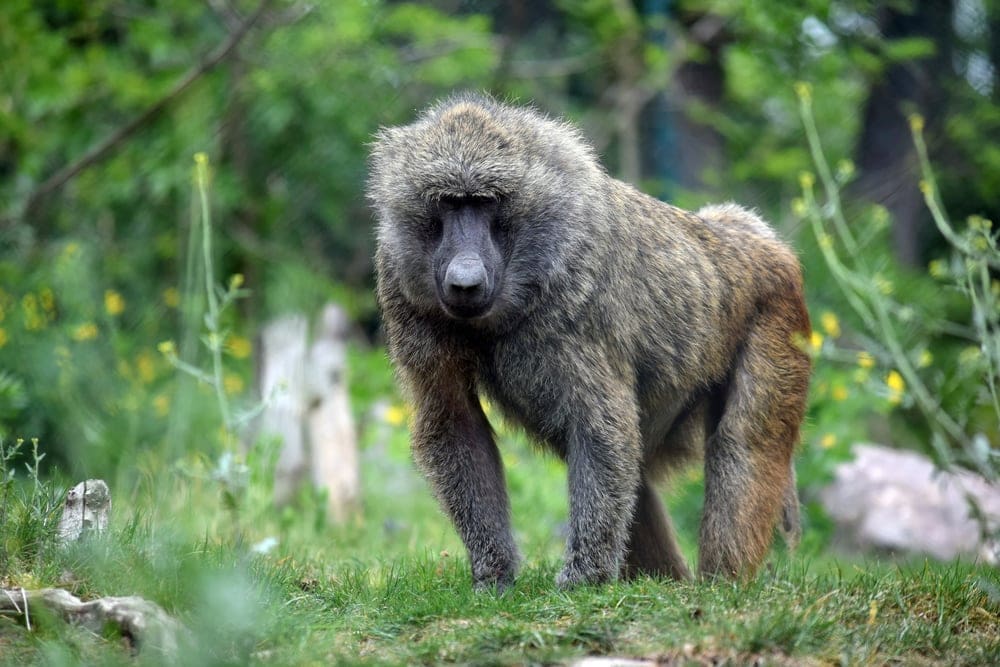


One of the most widely-distributed primates in the world, the olive baboon can be found in more than two dozen countries in Africa. It can live in a variety of habitats, including forests, steppes, and savannahs where it lives in complex social groups.
Olive baboons have brownish-grey colored coats and they walk on the ground using all four limbs. You will often see mother baboons harrying their young on their backs as they walk.
Many people think that olive baboons look quite a lot like a dog, thanks to their long muzzle. They often have large rumps and curved tails, which give them a distinctive appearance.
Due to their vast range, the olive baboon is considered to be a species of least concern. Since they can live in a wide variety of habitats, scientists aren’t too concerned about their population, though diseases introduced by humans may be a potential problem in the future.
25. Blue Monkey (Cercopithecus mitis)


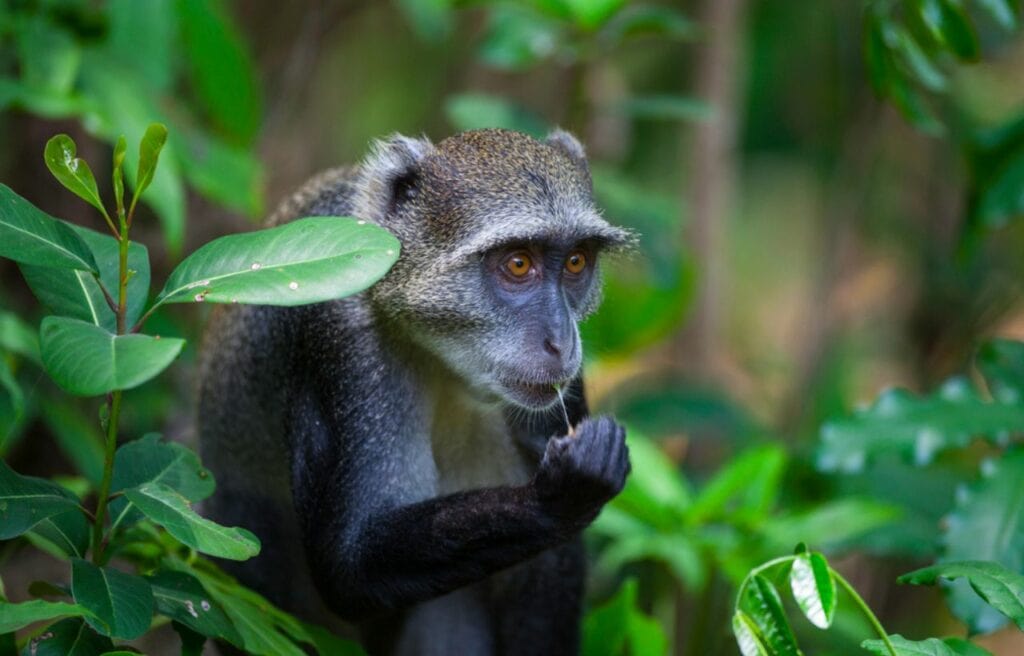
Distributed widely throughout eastern and central Africa, the blue monkey, or diamed, is a handsome-looking species that’s known to dwell high in the forest canopy.
Despite their name, blue monkeys are not blue. Instead, they are speckled grey in color with a white tuft under their chin.
These monkeys are considered to be very adaptable and there are about 16 subspecies found throughout their range. They have a very diverse diet that consists of fruit, eggs, small reptiles, and even small primates.
Although they are a species of least concern, the blue monkey is threatened by habitat loss. They are also hunted both for food and for traditional medicine, as well as to stop them from damaging crops in their home range.
You may also like: The 23 Different Types of Fascinating Foxes: Pictures, Facts and More
How Monkeys Are Classified

With so many species of monkeys out there, classifying all of them is a challenge. Thankfully, taxonomists have done the hard work for us, so we’re here to explain how monkeys are classified to clear the air once and for all.
All monkeys are classified within the kingdom Animalia, phylum Chordata, class Mammalia, and order Primates. The order Primates includes two suborders, so that’s where this classification system starts to get a little tricky.
The first suborder, Strepsirrhini, contains the lemurs, galagos (bush babies), and lorises, none of which are generally considered to be monkeys.
Therefore, all of the monkeys are classified within the suborder Haplorhini, which contains the monkeys, apes, and the tarsiers. Below the suborder Haplorhini, there are two infraorders, Tarsiiformes (tarsiers) and Simiiformes (simians/higher primates).
As tarsiers aren’t considered to be monkeys, either, we’ll focus on the infraorder Simiiformes. Within the infraorder Simiiformes, there are two parvorders, Platyrrhini (new world monkeys) and Catarrhini (old world monkeys and apes).
Thus, all monkeys are found in either the parvorder Platyrrhini or the parvorder Catarrhini. However, there are some important differences between the species within each of these two parvorders that are worth discussing here.
So, in this next section, we’ll offer you a closer look at the complex monkey classification system within these two parvorders.
1. Parvorder Platyrrhini (New World Monkeys)

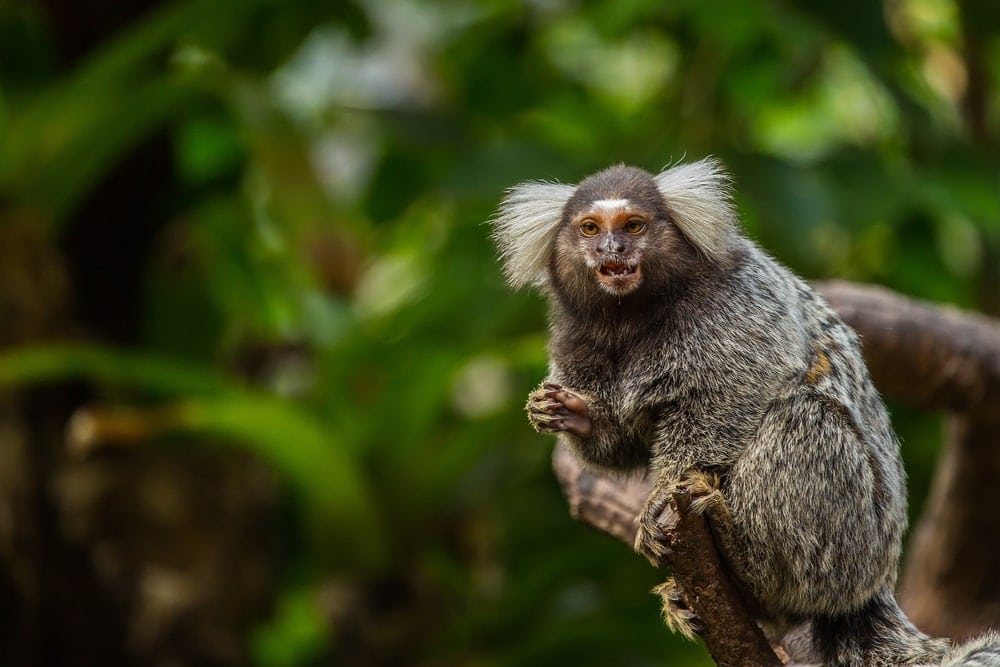

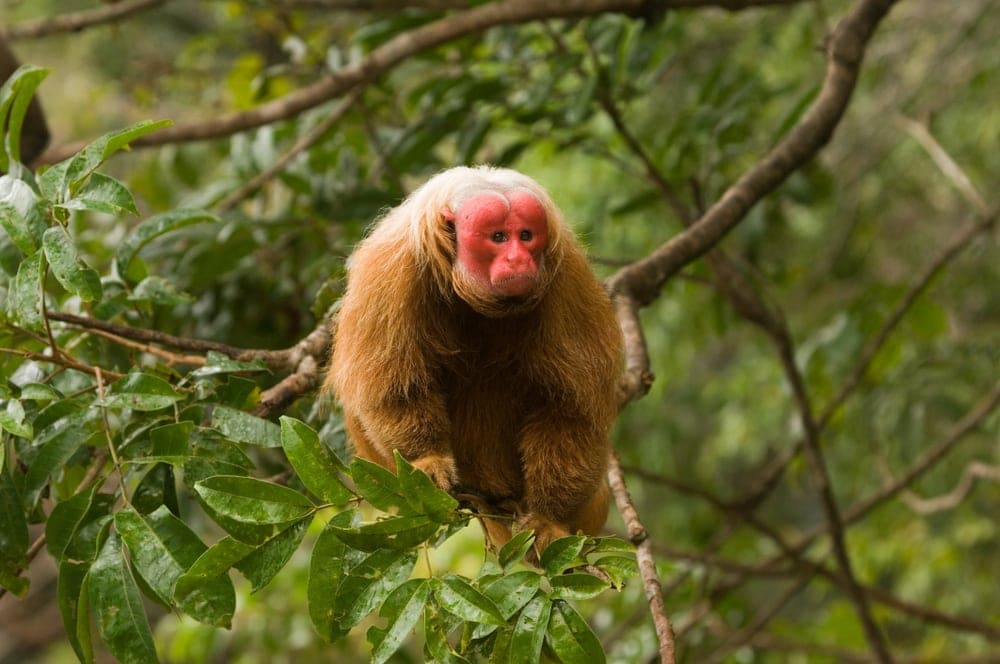

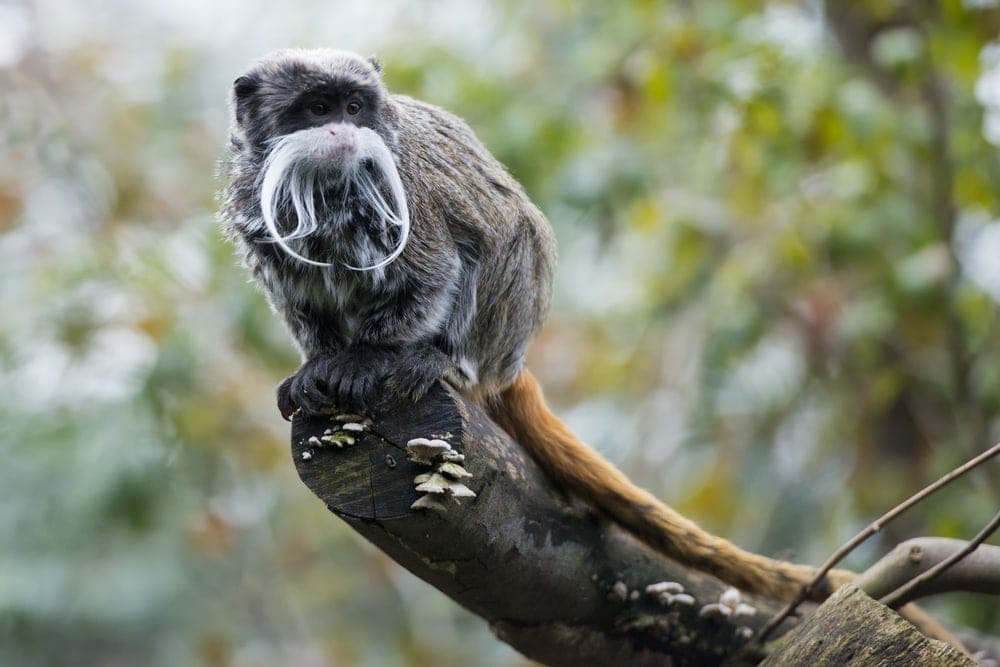
Our first parvorder, the parvorder Platyrrhini, contains all of what we commonly call the New World monkeys. These monkeys are found in the Americas, particularly in South America, Central America, and Mexico.
They have broad, flat noses with nostrils that face sideways rather than forward. Furthermore, the majority of New World monkeys are relatively small, though the main physical distinction between the Old and New World monkeys is their nose.
There are five families of New World monkeys, each of which has its own unique characteristics. These include:
1.1 Family Callitrichidae
The family Callitrichidae includes all of the monkeys that are commonly referred to as lion tamarins, tamarins, and marmosets. There are about 7 extant genera in this family, most of whom live in the Amazon River Basin.
These monkeys prefer to live in smaller groups in the upper canopies of the rainforest. Interestingly, these monkeys are one of the few primates that regularly have twins. While this can happen in other primates, it’s estimated that more than three-fourths of all Callitrichidae births are twins.
1.2 Family Cebidae
Home to the squirrel monkeys and the capuchins, the family Cebidae is native to South and Central America. Like other New World monkeys, this family prefers to live in the trees where they can find fruit and insects to feed on.
There are two subfamilies and three genera within this family. However, this family was once merged with the family Callitrichidae until scientific research showed that the capuchins and squirrel monkeys were genetically distinct from tamarins, lion tamarins, and marmosets.
1.3 Family Aotidae
The family Aotidae contains just one genus, Aotus. This genus is more commonly known as the night monkeys or the douroucoulis, which is a group of New World monkeys that lives throughout South America.
As their common name suggests, the night monkeys are active at night, thanks to their massive eyes, which provide them with great low-light vision. They usually form small social groups that they communicate with using an interesting collection of vocalizations.
Unfortunately, many night monkey species are classified as threatened or endangered due to habitat loss and illegal hunting. They are also one of the few species of monkeys that can be affected by malaria.
1.4 Family Pitheciidae
One of the more unique families of New World monkeys, the family Pitheciidae contains the titis, uakaris, and saki monkeys. These species are generally found in the Amazon River Basin, particularly in Brazil.
They tend to be medium- to small-sized with colorful patterning. There are more than 54 living types of monkeys in this family, making them one of the largest groups of New World monkeys.
1.5 Family Atelidae
The family Atelidae contains some of the largest New World monkey species. Within this family, you can find the spider monkeys, the woolly monkeys, the wooly spider monkeys, and the howler monkeys, all of which live in forested areas of Central and South America.
Although they are generally smaller than apes and Old World monkeys, the 29 species in the family Atelidae do have fairly large bodies. The spider monkeys are the smallest of the group, though they have prehensile tails, which is unique in the primate world.
2. Parvorder Catarrhini (Old World Monkeys and Apes)


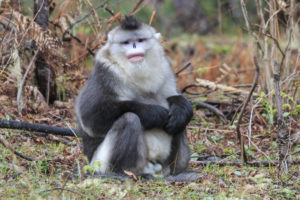



The second parvorder of monkeys, the parvorder Catarrhini, contains all of the primates called Old World monkeys as well as all of the apes. These primates are found primarily in Africa and Asia, though they are technically also found in Gibraltar, which is in Europe.
While New World monkeys are characterized by their flat noses and sideways-facing nostrils, Old World monkeys have larger and more defined noses with nostrils that face downward. Furthermore, Old World monkeys, if they have tails, will never have a prehensile tail, as we see with the spider monkeys.
There are two superfamilies within the parvorder Catarrhini, each of which contains a distinct collection of primate genera and species.
2.1 Superfamily Cercopithecoidea (Old World Monkeys)
The superfamily Cercopithecoidea contains all of what we call the Old World monkeys. As we’ve mentioned, these monkeys have distinct nose structures which help to differentiate them from New World monkeys. They also live only in Asia, Africa, and Europe, so the geographic differences make them easier to distinguish from their New World counterparts.
Within the superfamily Cercopithecoidea, there are 24 genera and 138 recognized species. This makes them one of the largest primate families. In fact, this superfamily contains the baboons, talapoins, mandrills, proboscis monkeys, and the macaques, all of which are quite large when compared to New World monkeys.
2.2 Superfamily Hominoidea (Apes)
Although this superfamily is home to the apes, which are not technically monkeys, the superfamily Hominoidea is well worth a mention here. This superfamily contains the gibbons and the great apes, all of which are tailless primates.
Within the superfamily Hominoidea, there are two families. These include:
- Family Hylobatidae – The family Hylobatidae, or the “lesser apes,” includes four genera and 16 species, which are all called gibbons. These primates are usually smaller and have less sexual dimorphism than the great apes. They also tend to use brachiation (swinging from branches) as their primary mode of transport.
- Family Hominidae – While the family Hylobatidae includes the lesser apes, the family Hominidae is home to the great apes. Also called hominids, the great apes include four genera and eight species, including various gorillas, orangutans, chimpanzees, bonobos, and humans. Great apes differ from lesser apes by being larger and more sexually dimorphic. These primates also move primarily bipedally (on two feet, like humans) or quadrupedally (on four feet, like gorillas).
You May Also Like: How Long Do Monkeys Live? From Old World To New World
General Monkey Biology

At this point, you’re a veritable expert in the world’s coolest monkey species and how they’re classified. That being said, we’d be remiss if we didn’t also clue you into some general monkey biology and facts for you to share with your friends and family. So, here are some key things that any primate enthusiast should know:

Habitat & Distribution
Monkeys are native to Africa, Asia, South America, Central America, and parts of Mexico. They were also introduced to Europe by the Moors during the Middle Ages, though the only current European population of monkeys lives in Gibraltar. Furthermore, monkeys were also introduced to parts of the United States, though these are highly isolated populations.
Monkeys are, as a group, very adaptable to a wide range of environments. They can live anywhere from the rainforest to the mountains. Additionally, many monkeys will live in urban areas where they quickly become habituated to humans.

Social Behavior
Most monkeys exhibit complex social behavior. They usually live in groups, called troops, which can vary from a small family group to a collection of many hundreds of individuals.
Like humans, most monkeys are very communicative. Depending on the species, they may communicate through sounds, facial expressions, and pheromones. They will also fight with each other, particularly over mates, but some monkeys have also been seen reconciling with others after a fight.

Diet & Eating Habits
Monkey diets vary widely depending on the species. Most monkeys will eat either fruit, nuts, seeds, tree sap and gum, or leaves. But, some species are more omnivorous and will eat insects, eggs, and even small animals. Others, like geladas, only eat grass. So, there’s a great variety in monkey eating habits.

Conservation Status
Monkeys and humans have a long history of both successful coexistence and conflict. Many cultures view certain species as sacred, while, in others, monkeys are hunted for food or for traditional medicine.
That being said, it is impossible to say that all monkeys are threatened or endangered. While approximately half of all monkey species are listed as at least threatened, many more are species of least concern.
The majority of species that are at risk of extinction are listed as such due to the effects of habitat loss, human conflict, hunting, or trapping for the international pet trade. However, some countries have instituted protections for vulnerable and endangered species to combat this issue.
You May Also Like: All The 33 Different Types of Seals: Chart, Pictures and Classifications
Monkey Fun Facts

Want to impress your friends with your monkey knowledge? Here are some great fun facts about monkeys that are great to have on hand:

Howler Monkeys Are Very Loud
With a name like “howler monkey,” it shouldn’t come as a surprise that these primates are very loud. Just how loud are howler monkeys, you might ask? Well, it turns out that their screeches can be heard from up to 3 miles (4.8 km) away in the forest!

Old World Monkeys Have Cheek Pouches
Have you ever had a meal that you loved so much that you wished you could save some for later? If only you were an Old world monkey. In fact, many Old World monkeys, like macaques, have cheek pouches that can be used to store food until a later meal. Who knew?

The Majority Of Monkeys Live In Tropical Forests
Although you can find monkeys in a variety of different habitats around the world, the majority of these primates live in tropical rainforests. There are only a few species, such as geladas, and snow monkeys, that prefer to live in grasslands or montane environments. Meanwhile, most are much more comfortable in the rainforest.
You may also like: Learn the 9 Different Types of Snakes That Slither in Texas: Complete with Facts, Images, Descriptions, and More!
Monkey FAQs

Here are answers to some of your most common questions about tthe differet types of monkeys:
Can Monkeys Hurt You?
When provoked or scared, monkeys can, indeed, hurt humans. Monkeys have been known to seriously injure humans, often while they are kept in captivity. Additionally, monkeys in the wild that have become very habituated to humans, such as those that like to hang around temples and tourist sites, can bite humans in search of food.
Therefore, while most monkeys generally don’t want anything to do with humans, it’s best to keep your distance from them, just in case.
What’s The Most Dangerous Monkey In the World?
While it’s hard to quantify precisely which species is the most dangerous, many people regard baboons and mandrills as particularly violent toward humans. However, the majority of monkey species are not interested in attacking humans so long as we stay far enough away.
What Animals Are Monkeys Afraid Of?
Monkeys, like humans, are very intelligent creatures. So, they don’t tend to run away from a situation for no reason. But, one study on animal behavior did find that rhesus monkeys are afraid of snakes, a fear that appears to be quite common in the primate world.
Can You Have A Monkey As A Pet?
While people have kept monkeys as pets over the millennia, it’s not a good idea. Monkeys are, for the most part, highly sociable creatures, so keeping them in captivity can be very stressful for them. Furthermore, monkeys are very difficult to care for and they can be violent when kept in captivity for too long.
Finally, many countries and local governments do not allow monkeys to be kept as pets. So, even though they look cute and cuddly, keeping a monkey as a pet generally isn’t a great choice.
Are Monkeys And Apes the Same Thing?
While they might look very similar, monkeys and apes are not the same animals. Apes all belong to the superfamily Hominoidea, which includes gorillas, orangutans, and, yes, humans. Meanwhile, monkeys are found in the superfamily Cercopithecoidea and the parvorder Platyrrhini.
On a practical level, apes generally have larger bodies, larger brains, and no tail. Meanwhile, monkeys usually have smaller bodies, long and thin arms, and a tail.










